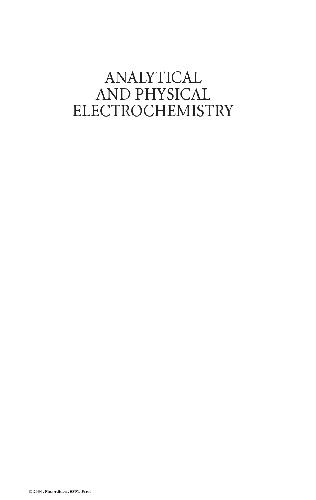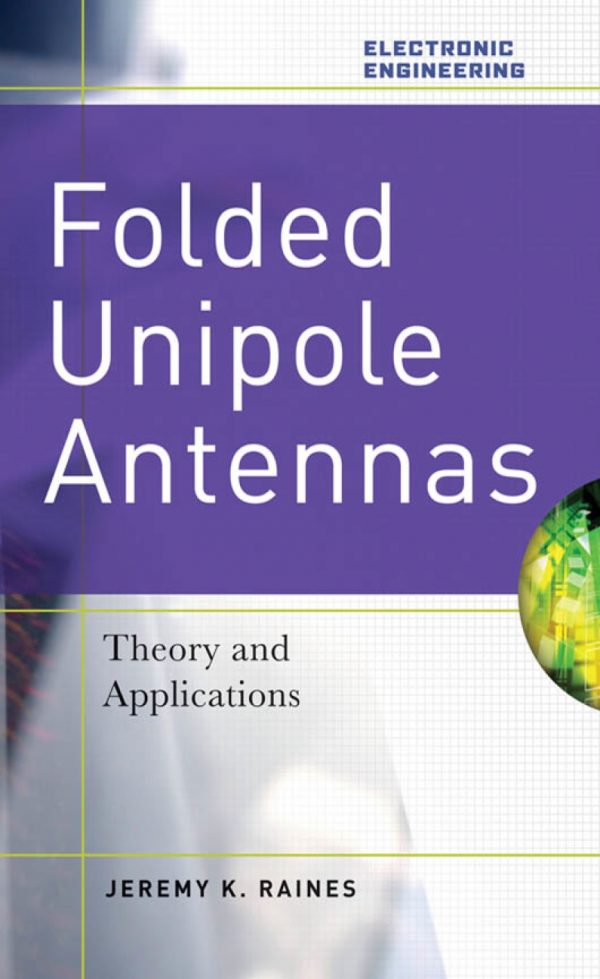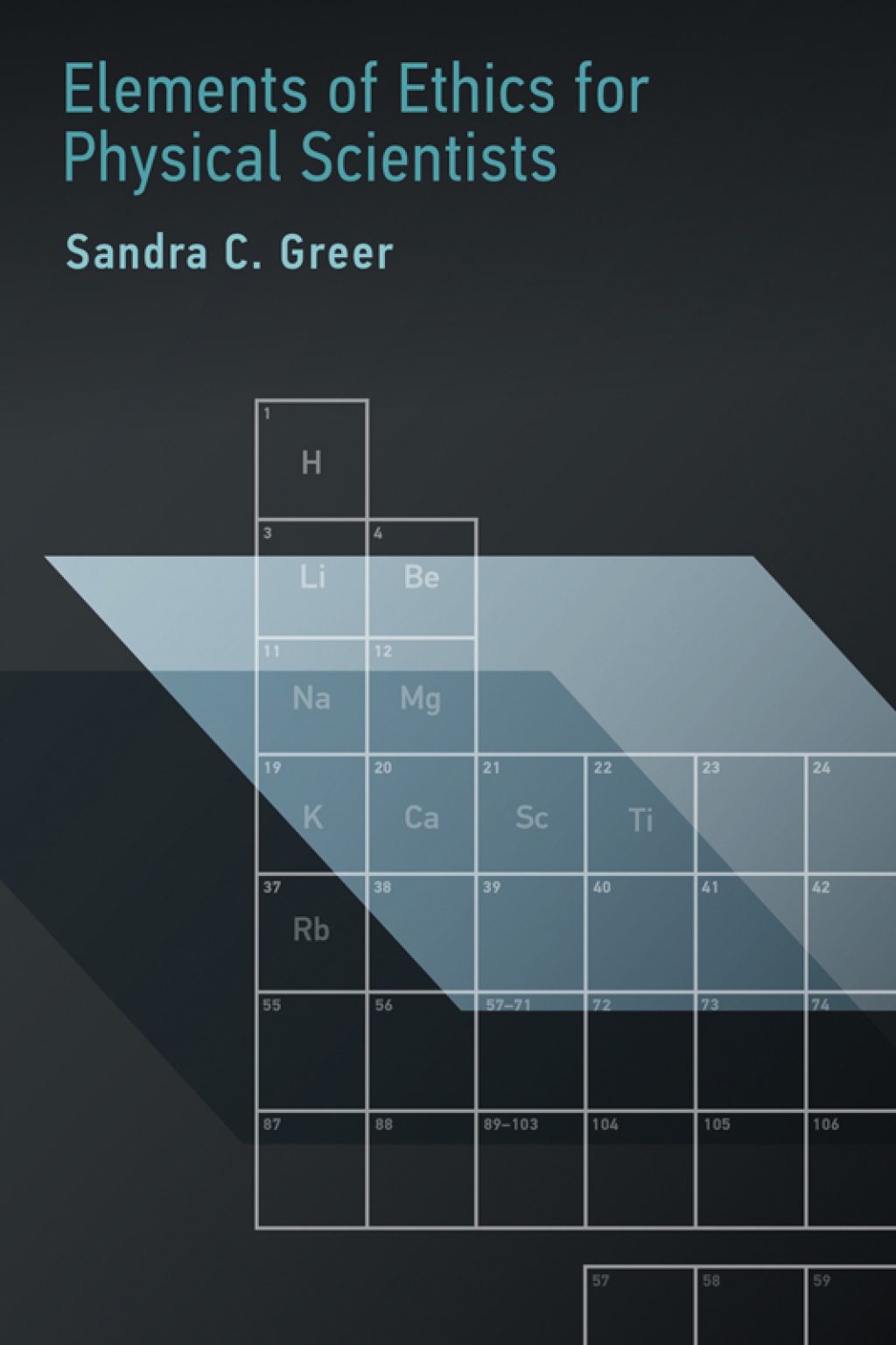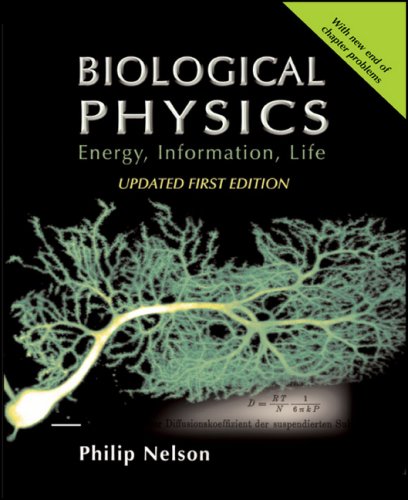H H Girault2940222037, 9782940222032, 0824753577, 9780824753573
Table of contents :
ANALYTICAL AND PHYSICAL ELECTROCHEMISTRY……Page 2
PREFACE……Page 5
PREFACE TO THE ORIGINAL FRENCH VERSION: “ELECTROCHIMIE PHYSIQUE ET ANALYTIQUE”……Page 6
TABLE OF CONTENTS……Page 8
SYMBOLS……Page 0
Thermodynamic definition……Page 11
Chemical potential in the gas phase……Page 13
Chemical potential in the liquid phase……Page 14
Mole fraction scale……Page 15
Molarity scale……Page 17
Application of chemical potentials……Page 18
The Gauss theorem……Page 19
Coulomb’s theorem……Page 20
Outer potential and the Volta potential difference……Page 21
Polarisation of matter……Page 22
Relative permittivity……Page 23
Electric displacement vector……Page 25
Surface of polar liquids……Page 26
Adsorbed ionised surfactants……Page 27
Metal surfaces……Page 28
1.1.5 The Galvani potential difference……Page 29
1.1.6 Electrochemical potential……Page 30
1.1.7 Chemical potential of a salt……Page 32
1.2.1 Band structure……Page 33
1.2.2 The Fermi-Dirac distribution……Page 35
1.2.3 Work function……Page 36
1.2.4 Contact between two metals……Page 37
1.2.5 The Kelvin probe……Page 38
1.2.6 Electrochemical potential of the electron in solution……Page 40
2.1.1 Galvani potential difference between an electrode and a solution……Page 42
Empirical approach……Page 44
A posteriori derivation of the Nernst equation……Page 45
Thermodynamic approach……Page 46
2.1.3 Standard redox potential……Page 47
Standard cell potential……Page 50
Measuring directly with a standard hydrogen electrode……Page 51
Measuring directly with a reference electrode……Page 53
Spectroelectrochemical measurements……Page 54
2.1.5 Absolute redox potential……Page 57
2.2.1 Voltaic cells……Page 59
2.2.2 Accumulators……Page 61
2.2.3 Fuel cells……Page 62
2.3 POURBAIX DIAGRAMS……Page 63
2.4.1 The Nernst equation for the distribution of ions between two phases……Page 66
2.4.2 Distribution potential……Page 67
2.4.4 Distribution diagrams……Page 69
2.4.5 Redox equilibria at the liquid | liquid interface……Page 71
Calomel electrode……Page 72
Silver | silver chloride electrode……Page 75
2.5.2 Potentiometric Titration……Page 76
Thermodynamic approach……Page 79
pH electrode……Page 82
The Nikolsky equation……Page 85
2.6.1 Structure……Page 87
2.6.2 Donnan potential……Page 88
APPENDIX : THE RESPIRATORY CHAIN……Page 91
3.1.1 Radial distribution function……Page 92
3.1.2 Water……Page 93
3.2 THERMODYNAMIC ASPECTS OF SOLVATION……Page 94
The Born-Haber cycle for NaCl(s)……Page 95
The Born-Haber cycle for HCl(aq)……Page 96
Electrochemical measurement of the standard formation enthalpies……Page 98
3.2.2 Standard enthalpies of ionic solvation……Page 100
3.2.3 The Born model……Page 102
3.2.5 Electrostatic Gibbs energy……Page 107
3.3.2 Solvation number……Page 109
3.3.3 Potential of a dipole……Page 111
3.3.5 Average ion-dipole interaction energy……Page 112
3.4.1 Electrostatic interaction energy and the activity coefficient……Page 114
3.4.2 The Debye-Hückel theory (1923)……Page 115
Calculation of the electric potential phi(r)……Page 118
Ionic atmosphere……Page 120
Calculation of the ionic activity coefficient……Page 122
Calculation of the average ionic activity coefficient of a salt……Page 124
Average ionic activity coefficient of a concentrated salt……Page 126
3.4.3 Electrochemical measurement of activity coefficients……Page 129
3.4.4 Kinetics of reactions between ions……Page 130
3.5.1 The Bjerrum theory (1923)……Page 132
3.5.2 Association constant……Page 134
3.5.3 The Fuoss theory……Page 136
3.6.1 The Monte-Carlo method……Page 138
3.6.2 Molecular dynamics……Page 139
APPENDIX……Page 140
4.1.1 Gradient of electrochemical potential……Page 141
4.1.2 Fick’s law for diffusion……Page 143
4.1.3 Ohm’s law for migration……Page 144
4.2.1 Limiting molar conductivity……Page 146
4.2.2 Measurement of conductivities……Page 148
4.2.3 Measurement of acidity constants……Page 151
4.3.2 Thermodynamic approach……Page 153
4.3.3 Electrophoretic effect……Page 154
4.3.4 Relaxation effect of the ionic atmosphere……Page 156
4.4.1 Electric field created by a dipole……Page 160
4.4.2 Relaxation of the dielectrics……Page 161
4.4.3 Dielectric friction coefficient……Page 164
4.5.2 Diffusion potential……Page 168
4.5.3 The Planck-Henderson equation……Page 170
4.6.1 Random motion in one dimension……Page 171
4.6.2 One-dimensional random motion with an absorbent wall……Page 173
Langevin’s equation……Page 175
Einstein’s diffusion equation in one dimension……Page 177
Tensor constraint for a viscous fluid……Page 179
Flow friction of a liquid around a sphere……Page 181
5.1.1 Surface Gibbs energy……Page 184
5.1.2 How is the surface Gibbs energy density linked to the mechanical properties of the interface?……Page 186
5.2.1 The Gibbs adsorption equation……Page 187
5.2.2 Surface excess concentration……Page 189
5.3.1 Mercury | electrolyte interface……Page 191
5.3.2 Electrolyte | electrolyte interface……Page 198
5.4.1 Metal | electrolyte interface……Page 201
The Gouy–Chapman theory……Page 202
Influence of the metal and the inner layer……Page 207
Potential of zero charge……Page 210
The Gouy–Chapman theory……Page 212
Intrinsic and extrinsic semiconductors……Page 215
Junction between a p-type semiconductor and a n-type semiconductor……Page 216
Accumulation, depletion and inversion layers……Page 220
5.5.1 Monocrystal | electrolyte interface……Page 222
5.5.2 Electrolyte | electrolyte interface……Page 226
6.1.1 Definitions……Page 228
6.1.2 Electro-osmosis……Page 229
6.1.3 Electrophoresis of charged colloids……Page 232
6.1.4 Streaming potential……Page 233
6.1.5 Sedimentation potential……Page 235
6.2.1 Capillary electro-osmotic flow……Page 236
6.2.2 Zone electrophoresis in a capillary……Page 238
6.2.3 Micellar electrokinetic capillary chromatography……Page 240
6.2.5 Capillary separation techniques not using electro-osmosis……Page 241
Electrokinetic injection……Page 242
Electrokinetic sample loop……Page 243
Columns and the effect of temperature……Page 244
Detection methods……Page 245
6.3.1 Moving boundary……Page 246
6.3.2 Isotachophoresis……Page 249
6.3.3 Zone electrophoresis……Page 250
Protein separation……Page 251
Separation of nucleic acids and the sequencing of DNA……Page 252
Movement of an ideal chain……Page 253
Reptation……Page 254
Reptation in an electric field……Page 255
Biased reptation in an electric field……Page 256
6.4.3 Isoelectric focusing……Page 259
Titration of a protein in a pH gradient gel……Page 260
‘Off-gel’ isoelectric separation……Page 261
6.5.1 Ion exchange chromatography……Page 263
6.5.2 Chromatography by ionic exclusion……Page 265
6.5.3 Ion pair chromatography……Page 266
6.5.4 Experimental methods……Page 267
6.6.1 Electrodialysis……Page 268
6.6.2 Donnan dialysis……Page 269
6.6.3 Ion exchange dialysis……Page 270
7.1 ELECTROCHEMICAL KINETICS……Page 271
7.2.1 Standard case of an ideal solution……Page 274
7.2.2 General case……Page 277
7.3.1 Diffusion layer……Page 281
7.3.2 Limiting diffusion current……Page 283
7.3.3 Current-potential curve……Page 284
7.4.1 Rotating disc electrode……Page 286
7.4.2 Microelectrodes……Page 288
Microhemispheres……Page 289
Recessed microdiscs……Page 290
7.4.3 Band electrode in a laminar flow……Page 291
7.4.4 Membrane-covered electrode……Page 292
7.4.5 Liquid | liquid micro-interfaces……Page 293
7.5.1 Current-potential curve……Page 294
7.5.3 Comments on the experimental measurement of rate constants……Page 298
7.6 IRREVERSIBLE SYSTEMS: CURRENT LIMITED BY KINETICS AND DIFFUSION……Page 300
7.7 QUASI-REVERSIBLE SYSTEMS: CURRENT LIMITED BY DIFFUSION, MIGRATION AND KINETICS……Page 301
7.8.1 Ohmic drop at a planar electrode……Page 302
7.8.2 Ohmic drop at a hemispherical electrode……Page 304
7.8.3 Compensating for the ohmic drop……Page 305
8.1.1 Chronoamperometry with semi-infinite linear diffusion for a complete interfacial oxidation……Page 306
8.1.2 Chronoamperometry with spherical diffusion for a complete interfacial oxidation……Page 310
8.1.3 Chronocoulometry with semi-infinite linear diffusion for complete interfacial oxidation……Page 312
8.1.4 Chronoamperometry with semi-infinite linear diffusion for a partial interfacial oxidation……Page 313
8.2.1 Dropping mercury electrode……Page 316
8.2.2 Staircase polarography with sampling (TAST Polarography)……Page 317
8.2.3 Normal pulse polarography……Page 319
8.2.4 Differential pulse polarography……Page 320
8.3.1 Superposition principle……Page 324
8.3.2 Constant amplitude alternate pulse voltammetry……Page 328
8.3.3 Staircase voltammetry……Page 331
8.3.4 Square Wave Voltammetry……Page 334
8.4.1 Anodic stripping voltammetry……Page 336
8.4.2 Cathodic stripping voltammetry……Page 337
8.5.1 Chronoamperometry in finite linear diffusion for complete interfacial oxidation……Page 338
8.5.2 Electrode covered with a thin membrane……Page 340
8.6 AMPEROMETRIC DETECTORS FOR CHROMATOGRAPHY……Page 342
9.1.1 AC response……Page 344
9.1.2 Linear Systems……Page 345
9.1.3 Impedance and admittance……Page 346
9.1.4 The Nyquist diagram……Page 347
9.2.1 Resistor……Page 348
9.2.2 Capacitor……Page 349
9.2.3 Resistor – capacitor in series……Page 350
9.2.4 Resistor – capacitor in parallel……Page 352
9.2.5 Resistor in series with a parallel resistor-capacitor circuit……Page 354
9.3.1 Impedance of a redox reaction……Page 356
9.3.2 Charge transfer impedance……Page 357
9.3.3 Concentration impedance……Page 358
9.3.4 Warburg impedance……Page 361
9.3.5 The Randles-Ershler circuit……Page 363
9.3.6 Concentration impedance for a diffusion layer of a fixed thickness……Page 365
9.3.7 Concentration impedance for diffusion in a thin layer cell……Page 370
9.4.1 Voltammetry using a superimposed sinusoidal potential difference……Page 373
9.4.2 Potential-modulated reflectance (fluorescence) spectroscopy……Page 376
10.1.1 Integration method……Page 379
10.1.2 Convoluted current……Page 385
10.2.1 Electrochemically quasi-reversible reactions……Page 386
10.2.3 Electrochemically irreversible reactions……Page 388
10.3.1 ECr reactions……Page 389
10.3.2 ECi reactions……Page 392
10.3.3 ECcat reactions……Page 395
10.4 ELECTRON TRANSFER AT LIQUID | LIQUID INTERFACES……Page 400
10.5 ASSISTED ION TRANSFER AT LIQUID | LIQUID INTERFACES……Page 403
10.6.1 Thin layer cell……Page 406
10.7 HEMI-SPHERICAL DIFFUSION……Page 408
10.8 VOLTABSORPTOMETRY……Page 411
10.9 SEMI-INTEGRATION……Page 412
SYMBOLS……Page 414
1 COORDINATE SYSTEMS……Page 418
2 CIRCULATION OF THE FIELD VECTOR……Page 419
3 THE VECTOR GRADIENT……Page 420
5 THE GREEN-OSTROGRADSKI THEOREM……Page 421
ANNEX B: WORK FUNCTIONS AND STANDARD REDOX POTENTIALS……Page 423







Reviews
There are no reviews yet.